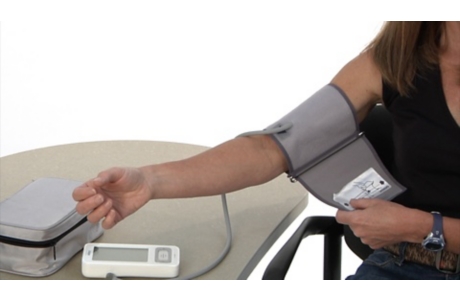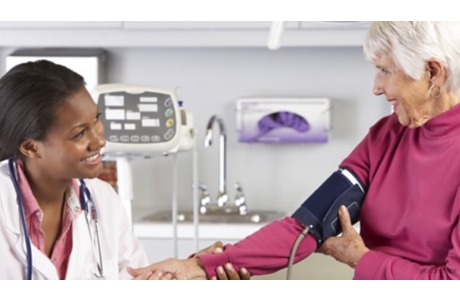Home Blood Pressure Test
Test Overview
Using a home blood pressure monitor lets you keep track of your blood pressure at home. Blood pressure is a measure of how hard the blood pushes against the walls of your arteries as it moves through your body.
Your blood pressure is recorded as two numbers.
- The first number shows how hard the blood pushes when the heart is pumping. This is the systolic pressure.
- The second number shows how hard the blood pushes between heartbeats, when the heart is relaxed and filling with blood. This is the diastolic pressure.
Someone with a systolic pressure of 120 and a diastolic pressure of 80 has a blood pressure of 120/80, or “120 over 80.” Blood pressure is measured in millimeters of mercury (mm Hg).
Automatic blood pressure monitors
Most people use an automatic monitor to measure their blood pressure at home. These are also called electronic or digital monitors. They have a microphone to detect blood pulsing in the artery. The cuff wraps around your upper arm. It automatically inflates when you press the start button.
This is the type of blood pressure monitor most often found in supermarkets, drugstores, and shopping malls.
Monitors used on the wrist aren’t as reliable as those that use arm cuffs. Wrist monitors should be used only by people who can’t use arm cuffs for physical reasons. And devices that use finger monitors aren’t recommended at all.
Manual blood pressure monitors
Manual models are like the ones that might be used in your doctor’s office. They usually include an arm cuff, a squeeze bulb to inflate the cuff, a stethoscope or microphone, and a gauge to measure the blood pressure.
To take your blood pressure, you inflate the cuff around your upper arm. This stops the flow of blood in the artery for a short time. You place the stethoscope on the skin over the artery. As you release air from the cuff, you listen for the sound of the blood as it starts to flow through the artery again.
The reading on the gauge when blood flow is first heard is the systolic pressure. The reading when blood flow can no longer be heard is the diastolic pressure.
Ambulatory blood pressure monitors
An ambulatory blood pressure monitor is a small device that you wear throughout the day, usually for 24 or 48 hours. It takes your blood pressure automatically.
Health Tools
Health Tools help you make wise health decisions or take action to improve your health.
Why It Is Done
You may check your blood pressure at home to:
- Find out if you have high blood pressure.
- Keep track of how well your blood pressure medicine is working.
- Check how lifestyle changes, such as weight loss and exercise, are affecting blood pressure. Home monitoring can help you feel more involved in and more in control of your health care.
- Watch for changes in blood pressure that may be side effects of medicines.
- Check for problems with high blood pressure during pregnancy or with preeclampsia. To learn more, see the topic Preeclampsia and High Blood Pressure During Pregnancy.
After measuring your blood pressure, your doctor may ask you to test it again when you are home. footnote 2This is because your blood pressure can change throughout the day. And sometimes blood pressure is high only because you are seeing a doctor. This is called white-coat hypertension. To diagnose high blood pressure, your doctor needs to know if your blood pressure is high throughout the day.
So your doctor may ask you to monitor your blood pressure at home to make sure that it actually is high. You may get an ambulatory blood pressure monitor or a home blood pressure monitor. These devices measure your blood pressure several times throughout the day.
How To Prepare
Before you take your blood pressure
- Don’t eat, smoke, or exercise for at least 30 minutes before you take your blood pressure. And don’t use any medicines that can raise blood pressure, such as certain nasal sprays.
- Rest at least 5 minutes before you take a reading. Sit in a comfortable, relaxed position with both feet on the floor.
- Try not to take your blood pressure when you are nervous or upset.
Ambulatory blood pressure monitoring
You do not need to do anything to prepare. The monitor will automatically take your blood pressure while you do your normal daily activities.
How It Is Done
Taking your blood pressure
Try to use the same arm for every reading. Readings may be 10 to 20 mm Hg different between your right arm and your left arm.
Ask your doctor:
- How often you should take your blood pressure. Your doctor may ask you to check it more often if your blood pressure is not well controlled or if you are taking new medicines or changing doses of a medicine.
- When you should take your blood pressure. Ask if you should take it at the same time each day or at different times of the day. Blood pressure readings are usually highest in the morning and lowest in the evening.
At first it is a good idea to take your blood pressure 3 times in a row, 5 or 10 minutes apart. As you get more used to taking your own blood pressure, you will only need to measure it once or twice each time.
The instructions may vary depending upon the type of blood pressure monitor you choose. Here are some general guidelines:
- Take your blood pressure while you feel relaxed. Before you start, sit quietly for at least 5 minutes with both feet on the floor.
- Sit with your arm slightly bent and resting on a table so that your upper arm is on the same level as your heart.
- Place the blood pressure cuff on the skin of your upper arm. You may have to roll up your sleeve, remove your arm from the sleeve, or take your shirt off.
- Wrap the blood pressure cuff snugly around your upper arm so that the lower edge of the cuff is about1 in. (2.5 cm) above the bend of your elbow.
- Try not to move or talk while you are taking your blood pressure.
If you have an automatic monitor, follow the instructions that came with it. When you press the start button, the cuff will inflate automatically. The cuff will then deflate and the numbers on the screen will begin to drop. When the measurement is complete, your monitor displays your blood pressure and pulse rate.
To learn more about using automatic and manual monitors, see:
How It Feels
You may feel some discomfort when the blood pressure cuff inflates, squeezing your arm.
Results
Your systolic and diastolic pressures are both important. Your doctor will give you a goal for your blood pressure. Your goal will be based on your health and your age.
It’s normal for blood pressure to go up and down throughout the day. Your doctor may want to track the results of your blood pressure over time to see if it stays in a high or low range.
In general, the lower your blood pressure, the better. For example, a blood pressure reading of less than 90/60 is healthy as long as you feel okay. Talk to your doctor if you have low blood pressure and feel lightheaded, faint, or like you may vomit.
What Affects the Test
It is normal for blood pressure to go up and down from day to day and even from moment to moment. Stress, smoking, eating, exercise, cold, pain, noise, medicines, and even talking can affect it.
One high reading does not mean you have high blood pressure. And one normal reading may not mean you do not have high blood pressure. It is more accurate to take the average of several readings made throughout the day than to rely on a single reading.
Some people have high blood pressure only when they go to their doctor’s office. This is called white-coat hypertension. It may be caused by stress about seeing your doctor. When you regularly check your blood pressure at home, you may find that your blood pressure is lower when you are not at the doctor’s office.
What To Think About
Do not adjust your blood pressure medicines based on home blood pressure readings unless your doctor tells you to.
References
Citations
- Whelton PK, et al. (2017). Guideline for the prevention, detection, evaluation, and management of high blood pressure in adults: A report of the American College of Cardiology/American Heart Association Task Force on Clinical Practice Guidelines. Journal of the American College of Cardiology, published online November 13, 2017. DOI: 10.1016/j.jacc.2017.11.006. Accessed November 20, 2017.
- U.S. Preventive Services Task Force (2015). Hypertension in adults: Screening and home monitoring: Final recommendation statement. http://www.uspreventiveservicestaskforce.org/Page/Document/RecommendationStatementFinal/high-blood-pressure-in-adults-screening. Accessed January 21 , 2016.
Other Works Consulted
- American Heart Association. (2005). Recommendations for blood pressure measurement in humans and experimental animals. Part 1: Blood pressure measurement in humans. AHA Scientific Statement. Hypertension, 45(1): 142–161.
- Pickering TG, et al. (2008). Call to action on use and reimbursement for home blood pressure monitoring. A joint scientific statement from the American Heart Association, American Society of Hypertension, and Preventive Cardiovascular Nurses Association. Hypertension, 52(1): 10–29.
Current as of: April 9, 2019
Author: Healthwise Staff
Medical Review:E. Gregory Thompson, MD – Internal Medicine & Martin J. Gabica, MD – Family Medicine & Kathleen Romito, MD – Family Medicine & Adam Husney, MD – Family Medicine
This information does not replace the advice of a doctor. Healthwise, Incorporated, disclaims any warranty or liability for your use of this information. Your use of this information means that you agree to the Terms of Use. Learn how we develop our content.







